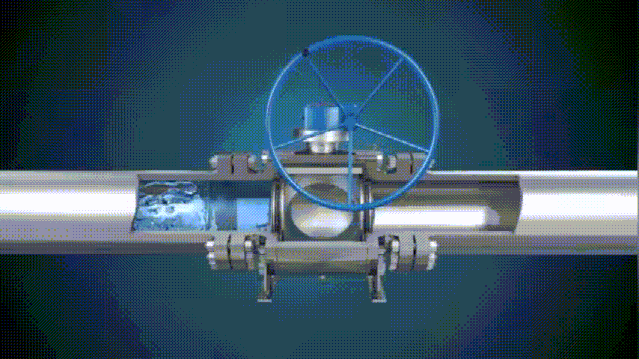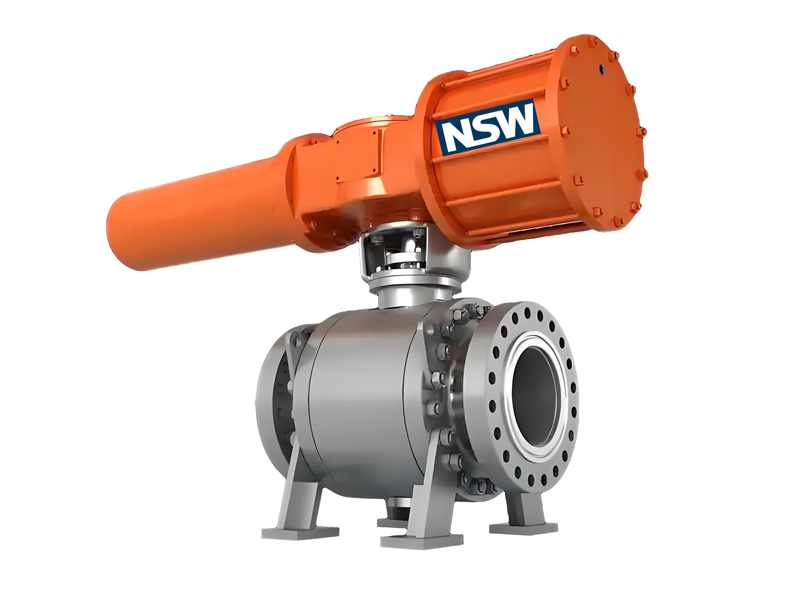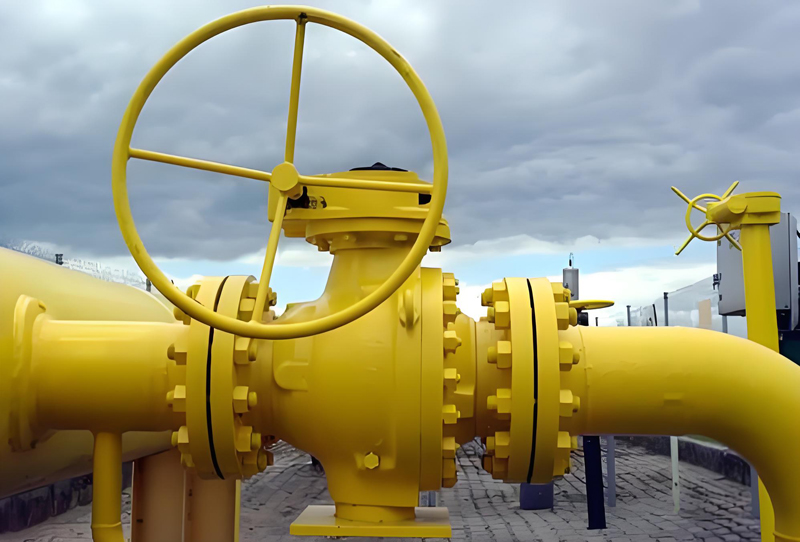Ball Valve, a valve whose opening and closing parts (ball) are driven by the valve stem and rotate around the axis of the ball valve. The hard-sealed V-type ball valve has a strong shear force between its V-type ball core and the metal valve seat welded with hard alloy, which is particularly suitable for media containing fibers, tiny solid particles, etc. The multi-way ball valve can not only flexibly control the confluence, diversion, and flow direction of the medium on the pipeline, but also close any channel to connect the other two channels. This type of valve should generally be installed horizontally in the pipeline. Ball valves are divided into pneumatic ball valves, electric ball valves, and manual ball valves according to the driving method.
What is A Ball Valve
A Ball valve were invented in the 1950s. With the rapid development of science and technology, the continuous improvement of production processes and product structures, ball valves have rapidly developed into a major valve type in just 40 years. In Western industrialized countries, the use of ball valves is increasing year by year.
In my country, ball valves are widely used in oil refining, long-distance pipelines, chemicals, papermaking, pharmaceuticals, water conservancy, electricity, municipal administration, steel and other industries, and they play an important role in the national economy. It has a 90-degree rotation action, the plug body is a sphere, and there is a circular through hole or channel passing through its axis.
Ball valves are mainly used to cut off, distribute and change the flow direction of the medium in the pipeline. It only needs to rotate 90 degrees and a very small torque to close tightly. Ball valves are most suitable for use as switches and cut-off valves, V-type ball valves. In addition to paying attention to pipeline parameters, electric valves should also pay special attention to the environmental conditions of their use. Since the electric device in the electric valve is an electromechanical device, its use status is greatly affected by its use environment.
What are the Characteristics of Ball Valves
- Wear resistance: since the valve core of the hard-sealed ball valve is alloy steel spray welding, the sealing ring is alloy steel surfacing, so the hard-sealed ball valve will not produce too much wear when switching. (Its hardness coefficient is 65-70):
- Good sealing performance: since the seal of the hard-sealed ball valve is manually ground, it can only be used until the valve core and the sealing ring are completely matched. So its sealing performance is reliable.
- Low Torque: since the bottom of the sealing ring of the hard-sealed ball valve uses a spring to hold the sealing ring and the valve core tightly together, the switch is very light when the external force exceeds the preload of the spring.
- Long service life: It has been widely used in various departments such as petroleum, chemical industry, power generation, papermaking, atomic energy, aviation, rockets, and people’s daily life.
What are the Advantages of Ball Valves
Compared with other types of valves, ball valves open quickly, smoothly and reliably, are widely used, and have the following advantages:
- The thrust bearing reduces the friction torque of the valve stem, which can make the valve stem operate smoothly and flexibly for a long time.
- Anti-static function: A spring is set between the ball, the valve stem, and the valve body to conduct static electricity generated during the switching process.
- Since materials such as polytetrafluoroethylene have good self-lubricating properties and small friction loss with the ball, the ball valve has a long service life.
- Small fluid resistance: Pneumatic ball valves have the smallest fluid resistance among all valve categories. Even for reduced-diameter pneumatic ball valves, their fluid resistance is quite small.
- Reliable valve stem seal: Since the valve stem only rotates but does not lift, the packing seal of the valve stem is not easy to be damaged, and the sealing ability increases with the increase of medium pressure.
- Good valve seat sealing performance: The sealing ring made of elastic materials such as polytetrafluoroethylene is easy to seal, and the sealing ability of the ball valve increases with the increase of medium pressure.
- Small fluid resistance, full-diameter ball valves have basically no flow resistance.
- Simple structure, small size and light weight.
- Tight and reliable. It has two sealing surfaces, and the sealing surface materials of the ball valve widely use various plastics, with good sealing performance and can achieve complete sealing. It has also been widely used in vacuum systems.
- Easy to operate, quick opening and closing, just rotate 90° from full open to full closed, convenient for long-distance control.
- Easy maintenance, the ball valve has a simple structure, and the sealing ring is generally movable, which is convenient for disassembly and replacement.
- When fully open or fully closed, the sealing surface of the ball and the valve seat is isolated from the medium, and the medium will not cause erosion of the valve sealing surface when passing through.
- Wide range of applications, diameters range from a few millimeters to several meters, and can be used from high vacuum to high pressure.
- Since the ball valve has a wiping property during the opening and closing process, it can be used in media with suspended solid particles.
- High processing precision, expensive cost, not suitable for use in high temperature, if there are impurities in the pipeline, it is easy to be blocked by impurities, resulting in the valve cannot be opened.
What are the Categories of Ball Valves
Function classification
- Bypass valve: ball valves are generally opened by static water, so bypass valves are set to level the pressure first, that is, both sides are filled with water;
- Air valve: when filling with water, the air is removed and the float closes the valve automatically; when draining, air is added and the float drops automatically;
- Pressure relief valve: when opening and closing the valve, the pressure water between the valve and the sealing cover is removed to avoid wearing the sealing cover;
- Drain valve: drain the sewage from the lower part of the ball shell.
Ball valve actuator classification
- Pneumatic Ball Valve
- Electric Ball Valve
- Hydraulic Ball Valve
- Pneumatic and hydraulic ball valve
- Electro-hydraulic ball valve
- Turbine transmission ball valve
Classification by ball valve shell/body material
- Metal Material Ball Valve: such as Carbon Steel Ball Valves, alloy steel valves, Stainless Steel Ball Valves, cast iron valves, Titanium alloy valves, monel valves, copper alloy valves, aluminum alloy valves, lead alloy valves, etc.
- Metal Body Lined Valves: such as rubber lined valves, fluorine lined valves, lead lined valves, plastic lined valves, enamel lined valves.
- Non-metallic Material Valves: such as ceramic valves, glass valves, plastic valves.
The Main Parameters of Ball Valve
- Nominal Pressure: PN1.0-42.0MPa, ANSI CLASS 150-2500, JIS10-20K
- Nominal Diameter: DN6~1200, NPS 1/4~48
- End Connection: flange, butt welding, thread, socket welding, etc.
- Applicable Temperature: -196℃~540℃;
- Operation: manual, worm gear transmission, pneumatic, electric, hydraulic, gas-liquid linkage, electro-hydraulic linkage;
- Valve Body Material: WCB, ZG1Cr18Ni9Ti, ZG1Cr18Ni12Mo2Ti, CF8(304), CF3(304L), CF8M(316), CF3M (316L), Ti., Different materials can be used for water, steam, oil, nitric acid, acetic acid, oxidizing medium, urea and other media.
Installation Method and Steps of Ball Valve on Pipeline
- Remove the protective covers on both sides of the flange end and rinse and clean the valve when it is fully open.
- Before installation, the whole machine should be tested according to the specified signal (electricity or gas) (to prevent vibration caused by transportation from affecting the performance), and it can be installed online only after passing the test (wiring according to the electric actuator circuit diagram).
- Before connecting to the pipeline, flush and clean the remaining impurities in the pipeline (these substances may damage the valve seat and ball).
- During installation, please do not use the actuator part of the valve as a lifting point to avoid damaging the actuator and accessories.
- This type of valve should be installed in the horizontal or vertical direction of the pipeline.
- The pipeline near the installation point must not sag or be subjected to external forces. Pipe brackets or supports can be used to eliminate pipeline deviation.
- After connecting to the pipeline, cross-tighten the flange connection bolts with the specified torque.
Applicable Occasions of Ball Valves
Since ball valves usually use rubber, nylon and polytetrafluoroethylene as valve seat sealing ring materials, their operating temperature is limited by the valve seat sealing ring material. The shut-off effect of the ball valve is achieved by the metal ball being pressed against the plastic valve seat under the action of the medium (floating ball valve). The valve seat sealing ring undergoes elastic-plastic deformation in local areas under a certain contact pressure. This deformation can compensate for the manufacturing accuracy and surface roughness of the ball and ensure the sealing performance of the ball valve.
Since the valve seat seal of the ball valve is usually made of plastic, the fire resistance and fire prevention of the ball valve should be considered when selecting the structure and performance of the ball valve, especially in the petroleum, chemical, metallurgical and other departments, and the use of ball valves in equipment and pipeline systems with flammable and explosive media should pay more attention to fire resistance and fire prevention.
Generally, ball valves are recommended in pipeline systems with double-position adjustment, strict sealing performance, mud, wear, shrinkage channel, rapid opening and closing action (1/4 turn opening and closing), high-pressure cut-off (large pressure difference), low noise, cavitation and gasification, small leakage to the atmosphere, small operating torque, and small fluid resistance.
Ball valves are also suitable for pipeline systems with light structures, low-pressure cut-off (small pressure difference), and corrosive media. Ball valves can also be used in low-temperature (deep cold) devices and pipeline systems. In the oxygen pipeline system of the metallurgical industry, ball valves that have been strictly degreased need to be used. When the main pipeline in the oil pipeline and gas pipeline needs to be buried underground, a full-bore welded ball valve needs to be used. When the regulating performance is required, a ball valve with a special structure with a V-shaped opening should be selected. In petroleum, petrochemical, chemical, electric power, and urban construction, metal-to-metal sealed ball valves can be selected for pipeline systems with working temperatures above 200 degrees.
Advantages and Disadvantages of Ball Valves
Ball Valve Advantages:
- It has the lowest flow resistance (actually 0);
- Because it will not get stuck during operation (when there is no lubricant), it can be reliably used in corrosive media and low-boiling liquids;
- It can achieve complete sealing within a large pressure and temperature range;
- It can achieve rapid opening and closing, and the opening and closing time of some structures is only 0.05~0.1s, so as to ensure that it can be used in the automation system of the test bench. When the valve is opened and closed quickly, the operation is impact-free.
- The spherical closing piece can automatically locate at the boundary position;
- The working medium is reliably sealed on both sides;
- When fully open and fully closed, the sealing surface of the ball and the valve seat is isolated from the medium, so the medium passing through the valve at high speed will not cause erosion of the sealing surface;
- The structure is compact and light, and it can be considered as the most reasonable valve structure for low-temperature medium systems;
- The valve body is symmetrical, especially the welded valve body structure, which can well withstand the stress from the pipeline;
- The closing piece can withstand the high pressure difference when closed. ⑾ The ball valve with a fully welded valve body can be buried directly underground, so that the valve internals are not corroded, and the maximum service life can reach 30 years. It is the most ideal valve for oil and natural gas pipelines.
Ball valve disadvantages
- Since the main valve seat sealing ring of the ball valve is made of poly tetra fluoro ethylene, it has a large expansion coefficient, is sensitive to cold flow, and has poor thermal conductivity. Therefore, when the sealing material hardens, the reliability of the seal will be damaged.
- In addition, polytetrafluoroethylene has low temperature resistance and can only be used at a temperature less than 180°C. If the temperature exceeds this temperature, the sealing material will age. Considering long-term use, it is generally only used at 120°C.
- Its adjustment performance is worse than that of the stop valve, especially the pneumatic valve (or electric valve).
Post time: Feb-11-2025









